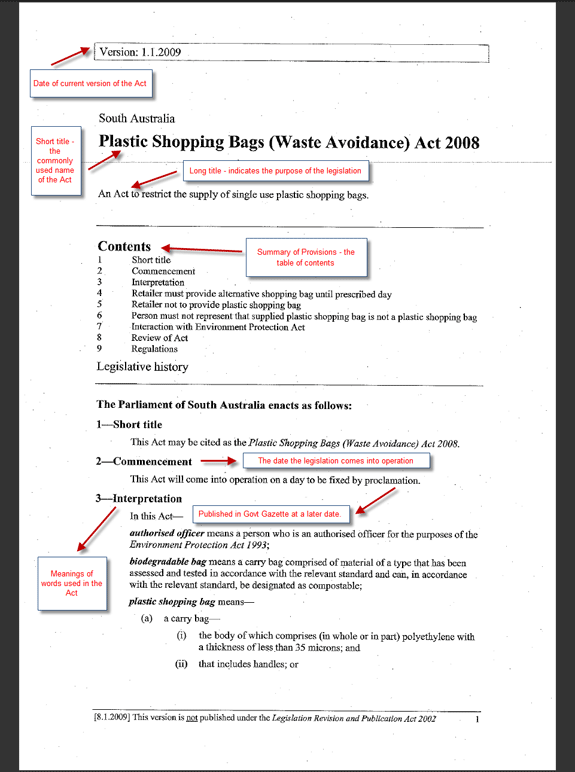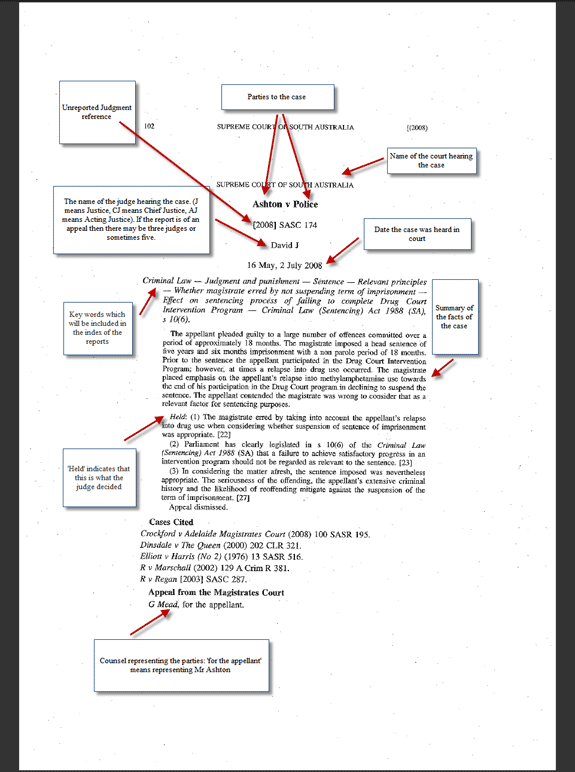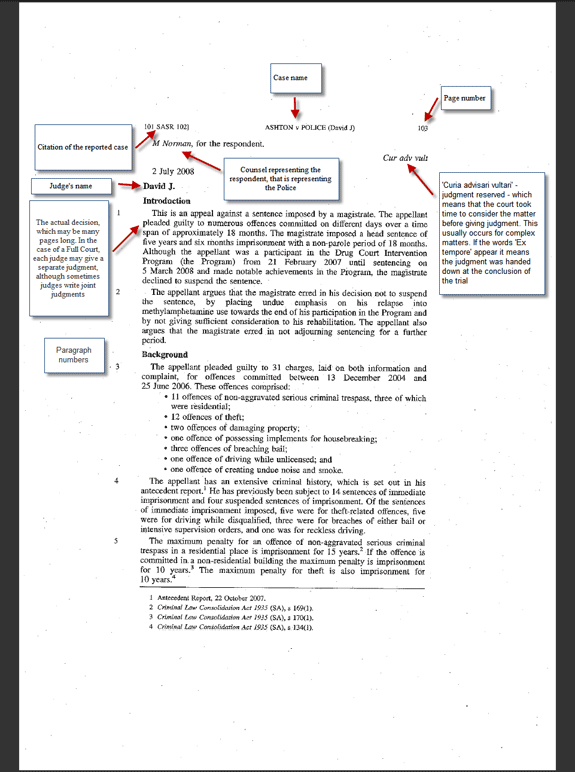

Finding the law is not always easy, even for legal professionals; however there are many reliable sources of free legal resources online. Many organisations also provide materials about the law written in plain English on their web sites, and courts and government agencies generally provide access to their judgments, legislation and publications. For more details see our Legal research Links.
Acts (also called statutes) have a name and date, for example the Road Traffic Act 1961 (SA). The name usually reflects the subject matter of the Act and the date indicates the year in which the Act passed through Parliament. Acts also have a number (for example, the Road Traffic Act was No. 50 of 1961 - that is, it was the 50th Act passed in 1961). All of the Acts passed in a particular calendar year are published in books called statute books. Acts can also be amended (changed) by Parliament at any time. Acts of particular jurisdictions may be reprinted. When they are reprinted, the principal (original) Act and all amendments are put together to make an up-to-date copy of the Act. In South Australia, reprints are published each time an Act is amended, unlike Commonwealth legislation which is reprinted only on a needs basis.
Regulations, Rules and by-laws are examples of delegated legislation (also called subordinate legislation), which is so named because Parliament has delegated power to a local council, government department or other body to make further laws under a particular Act. Delegated legislation is often of an administrative nature and may include standard forms and fee information. Regulations (known as statutory rules in the Commonwealth jurisdiction) generally contain material that changes frequently, so it is important that you locate an up-to-date copy.
If you have access to the Internet, you can find South Australian legislation at www. legislation.sa.gov.au and Commonwealth legislation on the Federal Register of Legislation site at https://www.legislation.gov.au/ . Legislation from other jurisdictions can be accessed via the Australasian Legal Information Institute site (www.austlii.edu.au). This information is free of charge, but make sure you take note of when the material for each jurisdiction was last updated, as the legislation may not be completely up-to-date.
Reading and understanding Acts is not easy; however most are now drafted (written) in simpler terms than they once were. Often an Act will have a Summary of Provisions (like a table of contents) at the front that lists and describes the sections of the Act. Usually there is a definition section near the beginning which explains what is meant by some of the words used in the Act. Some Acts have schedules at the end which may contain tables, forms for court documents, and other important information.
 |
Notes:
A substantial amount of case law is now available on the Internet. The AustLII (Australasian Legal Information Institute) site at www.austlii.edu.au contains full text judgments from most jurisdictions of Australia. The cases on AustLII are ‘unreported judgments’, as opposed to ‘reported decisions, which are those published in law reports (see below). The depth of coverage of judgments on AustLII is dependent on what is actually provided by the courts.
Law reports are books which contain reports of cases of special interest. A large proportion of cases are not reported, but the actual percentage will vary according to jurisdiction (e.g. A high percentage of High Court decisions is reported, but low numbers of South Australian cases are reported). There are many different law report series, each having a different name, and containing the more important decisions of certain courts or on a particular area of the law.
Cases are always referred to (cited) in a particular way, for example unreported South Australian cases are cited like this: Crispin v SA Police [2009] SASC 210, where Crispin and SA Police are the names of the parties to the case. SASC refers to the jurisdiction (South Australian Supreme Court), hence the citation refers to judgment number 210 of the SA Supreme Court for 2009.
Cases in law reports are cited in a similar manner. For example Brown v Dream Homes SA Pty Ltd (2008) 102 SASR 93. In this case the judgment can be found in volume 102 of the South Australian State Reports (abbreviated to SASR) at page 93.
Some cases are reported in more than one law report series, hence will have differing citations, for example:
and
Whenever the date of a case is cited in square brackets ([1970] SASR), it shows that a series uses a sequence of yearly volumes rather than of numbered volumes.
Each case within a law report series contains the names of the parties (the litigants), followed by the headnote (which gives an edited summary of the case and the court's decision), then the judgment (the reasons for the decision of the judge or judges) and finally the order of the court.
Each law report series has one or more indexes which can be used to find the citation of a particular case within that series, and also to look up cases on certain subjects. There are other reference tools designed to assist with research over multiple law report series or jurisdictions. Consult a law librarian for instruction in the use of these reference tools.
 |
 |
(Case headnote – Ashton v Police (2008) 101 SASR 102 – Reproduced with permission of Thomson Reuters (Professional) Australia Limited, www.thomsonreuters.com.au)
Further resources
South Australian legislation http://www.legislation.sa.gov.au
Commonwealth legislation https://www.legislation.gov.au/